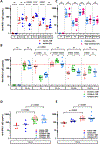Blood-stage malaria vaccine candidate RH5.1/Matrix-M in healthy Tanzanian adults and children; an open-label, non-randomised, first-in-human, single-centre, phase 1b trial
- PMID: 38880111
- PMCID: PMC12184842
- DOI: 10.1016/S1473-3099(24)00312-8
Blood-stage malaria vaccine candidate RH5.1/Matrix-M in healthy Tanzanian adults and children; an open-label, non-randomised, first-in-human, single-centre, phase 1b trial
Abstract
Background: A blood-stage Plasmodium falciparum malaria vaccine would provide a second line of defence to complement partially effective or waning immunity conferred by the approved pre-erythrocytic vaccines. RH5.1 is a soluble protein vaccine candidate for blood-stage P falciparum, formulated with Matrix-M adjuvant to assess safety and immunogenicity in a malaria-endemic adult and paediatric population for the first time.
Methods: We did a non-randomised, phase 1b, single-centre, dose-escalation, age de-escalation, first-in-human trial of RH5.1/Matrix-M in Bagamoyo, Tanzania. We recruited healthy adults (aged 18-45 years) and children (aged 5-17 months) to receive the RH5.1/Matrix-M vaccine candidate in the following three-dose regimens: 10 μg RH5.1 at 0, 1, and 2 months (Adults 10M), and the higher dose of 50 μg RH5.1 at 0 and 1 month and 10 μg RH5.1 at 6 months (delayed-fractional third dose regimen; Adults DFx). Children received either 10 μg RH5.1 at 0, 1, and 2 months (Children 10M) or 10 μg RH5.1 at 0, 1, and 6 months (delayed third dose regimen; Children 10D), and were recruited in parallel, followed by children who received the dose-escalation regimen (Children DFx) and children with higher malaria pre-exposure who also received the dose-escalation regimen (High Children DFx). All RH5.1 doses were formulated with 50 μg Matrix-M adjuvant. Primary outcomes for vaccine safety were solicited and unsolicited adverse events after each vaccination, along with any serious adverse events during the study period. The secondary outcome measures for immunogenicity were the concentration and avidity of anti-RH5.1 serum IgG antibodies and their percentage growth inhibition activity (GIA) in vitro, as well as cellular immunogenicity to RH5.1. All participants receiving at least one dose of vaccine were included in the primary analyses. This trial is registered at ClinicalTrials.gov, NCT04318002, and is now complete.
Findings: Between Jan 25, 2021, and April 15, 2021, we recruited 12 adults (six [50%] in the Adults 10M group and six [50%] in the Adults DFx group) and 48 children (12 each in the Children 10M, Children 10D, Children DFx, and High Children DFx groups). 57 (95%) of 60 participants completed the vaccination series and 55 (92%) completed 22 months of follow-up following the third vaccination. Vaccinations were well-tolerated across both age groups. There were five serious adverse events involving four child participants during the trial, none of which were deemed related to vaccination. RH5-specific T cell and serum IgG antibody responses were induced by vaccination and purified total IgG showed in vitro GIA against P falciparum. We found similar functional quality (ie, GIA per μg RH5-specific IgG) across all age groups and dosing regimens at 14 days after the final vaccination; the concentration of RH5.1-specific polyclonal IgG required to give 50% GIA was 14·3 μg/mL (95% CI 13·4-15·2). 11 children were vaccinated with the delayed third dose regimen and showed the highest median anti-RH5 serum IgG concentration 14 days following the third vaccination (723 μg/mL [IQR 511-1000]), resulting in all 11 who received the full series showing greater than 60% GIA following dilution of total IgG to 2·5 mg/mL (median 88% [IQR 81-94]).
Interpretation: The RH5.1/Matrix-M vaccine candidate shows an acceptable safety and reactogenicity profile in both adults and 5-17-month-old children residing in a malaria-endemic area, with all children in the delayed third dose regimen reaching a level of GIA previously associated with protective outcome against blood-stage P falciparum challenge in non-human primates. These data support onward efficacy assessment of this vaccine candidate against clinical malaria in young African children.
Funding: The European and Developing Countries Clinical Trials Partnership; the UK Medical Research Council; the UK Department for International Development; the National Institute for Health and Care Research Oxford Biomedical Research Centre; the Division of Intramural Research, National Institute of Allergy and Infectious Diseases; the US Agency for International Development; and the Wellcome Trust.
Copyright © 2024 The Author(s). Published by Elsevier Ltd. This is an Open Access article under the CC BY 4.0 license. Published by Elsevier Ltd.. All rights reserved.
Conflict of interest statement
Declaration of interests LDWK and SJD are named inventors on patent applications relating to RH5 malaria vaccines. AMM has an immediate family member who is an inventor on patent applications relating to RH5 malaria vaccines. CC is an employee of Novavax, developer of Matrix-M adjuvant. All other authors declare no competing interests.
Figures




References
-
- World Health O. World malaria report 2023. Geneva: World Health Organization; 2023.
-
- Datoo MS, Dicko A, Tinto H, et al. Safety and efficacy of malaria vaccine candidate R21/Matrix-M in African children: a multicentre, double-blind, randomised, phase 3 trial. Lancet 2024; 403(10426): 533–44. - PubMed
Publication types
MeSH terms
Substances
Associated data
Grants and funding
LinkOut - more resources
Full Text Sources
Medical
Miscellaneous

